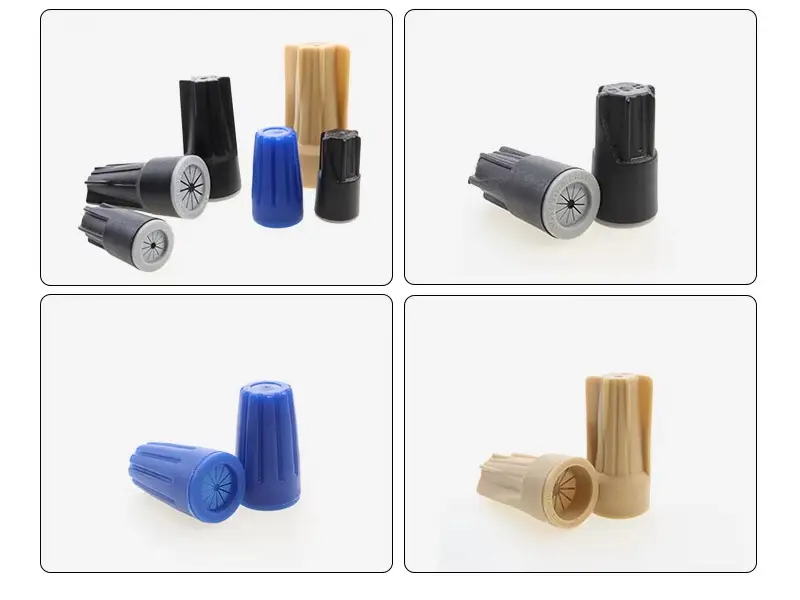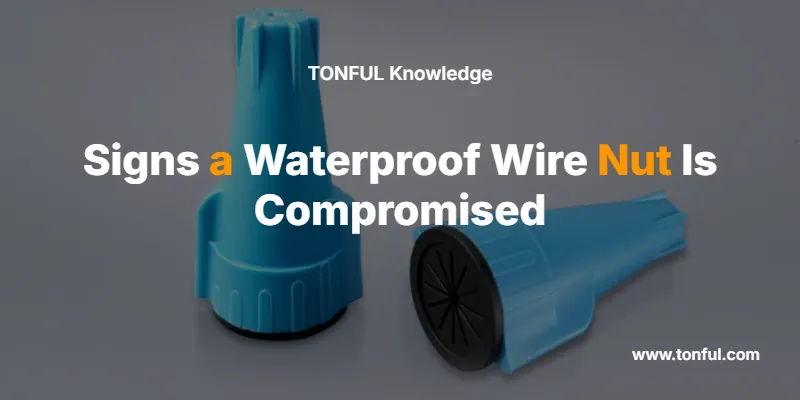Yes, there are 7 specific signs indicating a waterproof wire nut is compromised: visible corrosion on wires or connections, cracked or brittle silicone seals, moisture inside the connector cap, discolored or melted plastic housing, loose wire connections that pull out easily, burnt smell or heat marks, and failed continuity testing. Identifying these warning signs early prevents electrical fires, shock hazards, and equipment failure.
Understanding how to inspect waterproof wire nuts protects your electrical systems and keeps you safe. This guide shows you exactly what to look for, when to replace compromised connectors, and how to prevent future failures.
What Are Waterproof Wire Nuts?

Waterproof wire nuts are specialized electrical connectors designed to create moisture-sealed connections in wet or outdoor environments. Unlike standard wire nuts, they feature silicone or gel-filled caps that prevent water intrusion into electrical connections.
You use waterproof wire nuts in these common applications:
- Outdoor landscape lighting systems
- Underground electrical connections
- Swimming pool and spa wiring
- Marine electrical installations
- Irrigation control systems
- Outdoor HVAC connections
- Any direct burial electrical work
These connectors combine a traditional twist-on wire nut with a waterproof seal, typically rated for wet locations under NEC Article 110.11 and UL 486D standards.
7 Critical Signs Your Waterproof Wire Nut Is Compromised
1. Visible Corrosion on Wires or Connections
You see green, white, or rust-colored deposits on copper wires near or inside the connector. Corrosion appears as crusty buildup, discoloration, or powdery residue on the metal conductors.
What this means: The waterproof seal has failed, allowing moisture to contact bare copper and create oxidation. This increases electrical resistance and creates fire hazards.
2. Cracked or Brittle Silicone Seals
The outer silicone cap shows visible cracks, splits, or feels hard and brittle when you press it. Fresh waterproof wire nuts have flexible, pliable silicone that springs back when compressed.
What this means: UV exposure, temperature extremes, or age degradation has broken down the seal material. The connector can no longer prevent water intrusion.
3. Moisture or Condensation Inside the Cap
You observe water droplets, fog, or dampness inside the transparent portion of the connector when you inspect it. The gel or silicone seal appears diluted or separated.
What this means: The seal has been breached, and water has entered the connection chamber. This creates immediate shock and short-circuit risks.
4. Discolored or Melted Plastic Housing
The connector housing shows brown, black, or yellowed discoloration. In severe cases, you see melted or deformed plastic around the connection point.
What this means: Excessive heat from poor connections or overloading has damaged the connector. This indicates dangerous electrical resistance and potential fire hazards.
5. Loose Wire Connections
Wires pull out of the connector with minimal force, or you can wiggle them freely inside the nut. Properly secured connections require significant pulling force to remove.
What this means: The internal spring mechanism has failed, wire strands have corroded away, or the connector was never properly tightened. This creates arcing and overheating risks.
6. Burnt Smell or Visible Heat Marks
You detect an acrid, burnt plastic smell near the connection, or see black soot marks on or around the connector housing.
What this means: Arcing or high resistance has caused overheating. This is an immediate safety hazard requiring replacement before energizing the circuit.
7. Failed Continuity Testing
Your multimeter shows infinite resistance or intermittent readings when testing through the connection, despite properly secured wires.
What this means: Internal corrosion or poor contact has interrupted the electrical pathway. The connection is unreliable and must be replaced.
Waterproof Wire Nut Condition Comparison Table
Here is a table that shows the difference between compromised and properly functioning waterproof wire nuts:
| Component | Good Condition | Compromised Condition | Safety Risk Level |
|---|---|---|---|
| Silicone Seal | Flexible, pliable, no cracks | Hard, brittle, visible splits | High – allows moisture entry |
| Wire Condition | Bright copper, no corrosion | Green/white deposits, darkening | Critical – fire/shock hazard |
| Interior Cap | Dry, clear gel visible | Moisture, foggy, water present | Critical – immediate danger |
| Housing Color | Original color, no marks | Brown, black, yellow, melted | High – indicates overheating |
| Connection Tightness | Firm, requires force to remove | Loose, wires wiggle freely | Critical – arcing risk |
| Smell | No odor | Burnt plastic smell | Critical – active failure |
| Electrical Test | Continuous low resistance | Infinite or intermittent readings | High – unreliable connection |
| Age Indicators | Recent manufacture | 5+ years in harsh conditions | Medium – preventive replacement |
Step-by-Step Inspection Process for Waterproof Wire Nuts
Follow these steps to properly inspect your waterproof wire nut connections:
Step 1: De-Energize the Circuit
Turn off the circuit breaker and verify power is off using a non-contact voltage tester. Never inspect energized connections. This is the most important safety step.
Step 2: Visual External Examination
Look at the connector housing for cracks, discoloration, melting, or physical damage. Check the silicone seal for brittleness by gently pressing it to test flexibility.
Step 3: Check for Moisture
If the connector has a transparent section, look for water droplets, fog, or condensation inside. Inspect the ground around underground connections for moisture accumulation.
Step 4: Smell Test
Get close to the connector and check for burnt plastic or electrical fire odors. Any acrid smell indicates overheating and requires immediate replacement.
Step 5: Physical Connection Test
Gently tug on each wire entering the connector. Wires should resist pulling with significant force. Any movement or easy removal indicates failure.
Step 6: Electrical Continuity Testing
Use a multimeter set to continuity mode to test through the connection. You should get a consistent low-resistance reading with no intermittent breaks.
Step 7: Document and Tag
Mark any questionable connections with electrical tape for replacement. Take photos if inspecting multiple locations to track problem areas.
When to Replace Waterproof Wire Nuts
You must replace waterproof wire nuts immediately if you observe:
Critical Replacement Indicators:
- Any visible corrosion on wire strands
- Moisture or water inside the connector cap
- Burnt smell, heat marks, or melted plastic
- Loose connections that wiggle or pull out easily
- Failed continuity testing with intermittent readings
- Visible cracks or splits in the silicone seal
Preventive Replacement Schedule:
- Every 3-5 years in harsh outdoor environments (extreme heat, cold, UV exposure)
- Every 5-7 years in protected outdoor locations
- Every 10 years in semi-protected areas with minimal weather exposure
- Immediately after any flooding, submersion, or direct water contact events
⚠️ SAFETY WARNING: Never attempt to “repair” a compromised waterproof wire nut with tape, sealant, or other methods. Always replace the entire connector with a new, properly rated unit. Makeshift repairs create serious fire and shock hazards.
Why Waterproof Wire Nuts Fail: Common Causes
Understanding failure modes helps you prevent future problems:
Environmental Factors:
- UV radiation breaking down silicone compounds over time
- Freeze-thaw cycles causing micro-cracks in seals
- Saltwater or chemical exposure accelerating corrosion
- Extreme temperature fluctuations degrading materials
Installation Issues:
- Insufficient wire strip length preventing proper contact
- Over-tightening causing internal damage to spring mechanism
- Under-tightening allowing moisture entry and loose connections
- Mixing wire gauges exceeding connector capacity
Material Degradation:
- Age-related breakdown of silicone and gel compounds
- Manufacturing defects in seal quality
- Incompatible wire metals creating galvanic corrosion
- Poor-quality counterfeit connectors with inadequate sealing
Expert Tips for Waterproof Wire Nut Longevity
Installation Best Practices:
Use dielectric grease on wire strands before insertion to provide additional moisture protection and improve conductivity. This creates a secondary moisture barrier inside the connection.
Strip wires to the exact length specified by the manufacturer, typically 5/8 to 3/4 inch for most residential connectors. Too little bare wire reduces contact area; too much creates exposure risks.
Twist wires together clockwise before adding the connector to create a mechanical connection independent of the wire nut. This prevents reliance solely on the internal spring.
Inspection Schedule:
Inspect outdoor connections every 6 months in harsh environments (coastal, extreme climate, direct sun exposure). Annual inspection suffices for protected outdoor locations.
Check all connections after major weather events including hurricanes, flooding, heavy storms, or extreme temperature swings that might compromise seals.
Product Selection:
Choose UL 486D listed connectors specifically rated for direct burial if installing underground. Not all “waterproof” wire nuts meet direct burial standards under NEC 300.5.
Select connectors with clear or translucent caps allowing visual inspection without removal. This enables non-invasive monitoring of connection condition.
Use connectors rated for at least 600 volts and appropriate amperage for your circuit. Oversizing the connector capacity provides safety margin and reduces overheating risks.
Electrical Code Compliance for Waterproof Connections
Waterproof wire nut installations must meet these National Electrical Code requirements:
NEC Article 110.11: All equipment and connections must be suitable for the environment where installed. Waterproof wire nuts must carry appropriate wet location ratings.
NEC Article 110.14(A): Terminals and conductors must be protected from moisture where exposed to wet conditions. Standard wire nuts cannot be used in wet locations without additional protection.
NEC Article 300.5: Direct burial connections require connectors specifically listed for direct burial applications, not just “waterproof” rated connectors.
NEC Article 406.9: Outdoor receptacles and connections must be protected with weatherproof enclosures when wet location rated connectors are used.
Always verify your installation meets local electrical codes and obtain required permits for outdoor electrical work. Some jurisdictions have additional requirements beyond the NEC.
What to Do If You Find a Compromised Connector
Follow this immediate action protocol:
Step 1: Disconnect Power
Turn off the circuit breaker immediately if you discover any critical compromise signs. Do not operate the circuit until repairs are complete.
Step 2: Assess Extent of Damage
Check all nearby connections in the same system. Failure of one connector often indicates similar age or environmental stress on adjacent connections.
Step 3: Replace with Proper Materials
Install new waterproof wire nuts rated for your specific application. Use higher-quality connectors if the originals failed prematurely.
Step 4: Address Root Causes
Identify why the failure occurred and correct the issue. This might include adding UV-protected enclosures, improving drainage, or relocating connections to better-protected areas.
Step 5: Consider Professional Help
Licensed electricians should handle any installation where you find evidence of arcing, burning, or extensive corrosion. These indicate serious safety issues requiring expert assessment.
⚠️ PROFESSIONAL RECOMMENDATION: If you discover multiple compromised connections, extensive corrosion, or any signs of overheating, hire a licensed electrician to inspect the entire system. This may indicate larger problems with circuit design, overloading, or installation quality.
Waterproof Wire Nut Selection Guide
Choose the right connector for your application using these criteria:
For Outdoor Landscape Lighting:
- Silicone gel-filled connectors rated for direct burial
- UL 486D listed for underground use
- Size appropriate for 12-18 AWG landscape lighting wire
- Clear caps for visual inspection
For Pool and Spa Applications:
- Marine-grade waterproof connectors with enhanced corrosion resistance
- Listed for wet locations per NEC Article 680
- Rated for chlorine and chemical exposure
- Stainless steel or corrosion-resistant internal springs
For Direct Burial Connections:
- NEC 300.5 compliant direct burial rated connectors
- Gel-filled design providing superior moisture exclusion
- Rated for underground temperature extremes
- UV-resistant housing if any portion exposed to sunlight
For General Outdoor Use:
- UL 486D wet location listed connectors
- Silicone or gel-filled caps
- Appropriate voltage and amperage ratings
- Transparent or translucent inspection windows
Prevention: Maximizing Waterproof Wire Nut Lifespan
Implement these preventive strategies to extend connector life:
Environmental Protection:
- Install connections inside weatherproof junction boxes when possible
- Bury underground connections at proper NEC-required depths
- Apply UV-resistant sealant around wire entry points in exposed locations
- Ensure proper drainage preventing water accumulation around connections
Quality Installation:
- Use only connectors from reputable manufacturers (3M, Ideal, Gardner Bender)
- Follow manufacturer torque specifications for tightening
- Apply dielectric grease before making connections
- Create drip loops preventing water from running down wires into connectors
Regular Maintenance:
- Implement inspection schedules based on environmental exposure
- Replace connectors proactively based on age and condition
- Clean and reseal junction boxes during routine inspections
- Document installation dates and inspection findings
System Design:
- Minimize the number of outdoor connections through better planning
- Use continuous wire runs where possible instead of multiple splices
- Route wiring to avoid standing water and high-moisture areas
- Specify higher-quality connectors for critical circuits
Frequently Asked Questions
How long do waterproof wire nuts typically last outdoors?
Waterproof wire nuts typically last 5-7 years in protected outdoor locations and 3-5 years in harsh environments with direct sun exposure, extreme temperatures, or coastal conditions. Direct burial installations may last 7-10 years when properly installed with quality connectors. Regular inspection allows you to identify failures before they cause problems.
Can I reuse a waterproof wire nut that looks okay?
No, you should never reuse waterproof wire nuts once removed. The internal spring mechanism weakens with each use, and the silicone seal loses its effectiveness when disturbed. The gel or compound inside may not reseal properly, compromising moisture protection. Always use new connectors for electrical safety and code compliance.
What’s the difference between waterproof and standard wire nuts?
Waterproof wire nuts include silicone caps, gel filling, or rubber seals that prevent moisture intrusion into connections. Standard wire nuts have open vents allowing moisture to contact bare wires. Waterproof versions carry UL 486D wet location listings, while standard wire nuts are rated only for dry locations. You must use waterproof connectors in any outdoor, underground, or wet location applications per NEC requirements.
Do waterproof wire nuts need to be in a junction box?
The answer depends on your application. Direct burial rated waterproof wire nuts can be installed underground without junction boxes per NEC 300.5 when properly rated. Above-ground outdoor connections should be installed in weatherproof junction boxes for additional protection and code compliance. Indoor wet locations require appropriate enclosures per NEC Article 314. Always check local electrical codes for specific requirements in your area.
Can corrosion inside a waterproof wire nut be cleaned?
No, you cannot effectively clean corrosion from inside wire nut connections. Once corrosion appears, you must cut back the corroded wire section to fresh copper, strip new wire, and install a new waterproof connector. Attempting to clean corroded connections leaves residual oxidation that continues causing high resistance and poor conductivity. This creates ongoing fire and failure risks.
What causes waterproof wire nuts to fail in direct burial applications?
Direct burial failures typically result from inadequate burial depth allowing freeze-thaw damage, soil chemicals degrading silicone seals, water pressure forcing moisture past seals, poor-quality connectors not rated for burial, improper wire preparation leaving gaps, and age degradation of seal materials over time. Using NEC 300.5 compliant direct burial rated connectors and proper installation techniques prevents most failures.
How do you test if a waterproof wire nut is still good?
You test waterproof wire nuts by performing visual inspection for cracks or corrosion, physical seal flexibility testing, gentle wire pull testing for secure connections, multimeter continuity testing through the connection, and voltage drop testing under load conditions. Any abnormal findings in these tests indicate the connector should be replaced immediately. Annual testing in harsh environments and biennial testing in protected locations helps catch failures early.
Are gel-filled or silicone cap waterproof wire nuts better?
Gel-filled connectors provide superior moisture exclusion and better corrosion protection for direct burial applications. Silicone cap connectors work well for above-ground outdoor use and allow easier visual inspection. Gel-filled types cost more but last longer in harsh conditions. Choose gel-filled for underground installations and severe weather environments. Select silicone cap connectors for protected outdoor locations where visual monitoring is important.
Conclusion: Protect Your Electrical Systems Through Vigilant Inspection
Recognizing the 7 critical signs of compromised waterproof wire nuts protects your property from electrical fires, prevents dangerous shock hazards, and ensures reliable system operation. Regular inspection every 6-12 months catches failures before they cause damage.
Replace any connector showing corrosion, moisture intrusion, cracked seals, discoloration, loose connections, burning signs, or failed testing immediately. Never attempt to repair compromised connectors—always install new, properly rated replacements following manufacturer specifications and electrical code requirements.
Your next step: Inspect your outdoor electrical connections today using the step-by-step process outlined above. Create a regular maintenance schedule based on your environmental conditions. When you find questionable connections, replace them proactively with high-quality, properly rated waterproof wire nuts.
For installations showing multiple failures, extensive corrosion, or any signs of overheating, consult a licensed electrician to evaluate your entire electrical system. Professional assessment ensures your electrical work meets safety standards and protects your most valuable investment—your property and your family’s safety.

